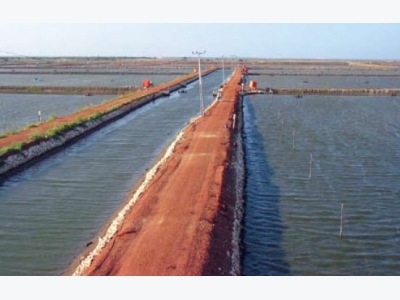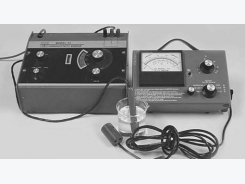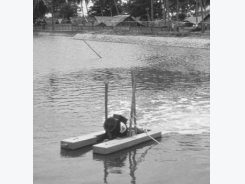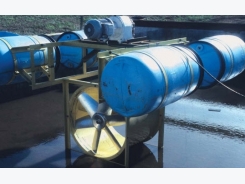Water Temperature in Aquaculture

Aquaculture ponds should not be deeper than about 2.0 m to minimize the probability of thermal stratification.
Summary:
Water temperature is a key water quality variable in aquaculture because it influences other vari-ables, defines growing seasons and dictates what species can be grown at a particular location. It also influences the occurrence of infectious diseases and animals’ immune functions. The surface of water heats much faster than deeper layers, which can cause thermal stratification. Shallow pond design and aeration can reduce stratification issues.
Water temperature is a key water quality variable because it influences all other water quality variables and aquatic organisms, as well. Air temperature is controlled mainly by solar radiation, and it varies more or less predictably with sea-son and time of day. Water in ponds and other outdoor aquaculture systems also receive direct insolation.
However, water warms more slowly than air because of its great specific heat of 1 calorie/g/° C. On sunny or partly cloudy days, pond water has its lowest temperature in the early morning and its highest temperature in the early after-noon – as does the air.
Water can store considerable heat because of its high specific heat. Heat stored in pond water is lost to the air when the air is cooler than the water.
Because water releases heat rather slowly, brief periods of unseasonably cool weather do not cause drastic changes in water temperature in ponds. Neverthe-less, if cool conditions persist for a few days, pond water temperature will equili-brate with the air temperature. When considered over periods longer than sev-eral days, water temperature closely tracks air temperature.
Water temperature influences the length of the growing season and the spe-cies that can be grown at a particular loca-tion. For example, tilapia, a tropical species, will die during winter in the temperate zone. Channel catfish, a warmwater, tem-perate zone species, can survive year-round in the temperate zone, but will not feed and grow during winter. Coldwater species do not survive well at temperatures above about 20° C, and warmwater species do not occur in cold climates.
Thermal Stratification
Light adsorption and heating of water are magnified by the presence of sus-pended particles, especially plankton and other organic matter. Light penetration into water declines exponentially with depth, so the surface layer heats much faster than deeper layers
Warm water is less dense than cooler water and floats on top of it in the absence of strong mixing forces. In lakes and even small bodies of water greater than 1.5 or 2.0 m in depth, the warmer surface layer Warm water is less dense than cooler water and floats on top of it in the absence of strong mixing forces. In lakes and even small bodies of water greater than 1.5 or 2.0 m in depth, the warmer surface layer
When air temperatures decline in the cooler seasons, surface water cools until its density is low enough that wind can mix it with deeper water. Thermal destratification also can occur in the sum-mer in response to unseasonable cool spells, heavy rains or strong winds.
Thermal stratification obviously can occur in tropical waters. Small tropical water bodies typically stratify and destrat-ify annually. Destratification may not be caused by falling air temperature, but as a result of stronger winds or heavy rains during the wet season. Rain water is cooler and denser than warm pond water and sinks, causing upwelling and destrati-fication. Large, deep tropical lakes stratify but tend not to destratify annually. Most destratify on an irregular basis as a result of weather conditions.
The surface layer of a stratified water body is called the epilimnion. The deeper, cooler layer is known as the hypolimnion, and the transitional layer of rapidly chang-ing water temperature between the two is known as the thermocline.

Water Quality Deterioration
Because the hypolimnion does not receive enough light for photosynthesis, and organic particles settle into it, its water quality often becomes impaired by dissolved oxygen depletion and high con-centrations of organic matter and other reduced substances during stratification. Sudden destratification mixes epilimnetic water with hypolimnetic water, which can result in water quality deterioration throughout the water column and mor-tality of culture animals.
Destratification of lakes containing cage culture operations can be especially disastrous. Low dissolved-oxygen con-centrations following sudden destratifica-tion have caused complete mortality of fish in cages. The likelihood of sudden destratification and its possible conse-quences on culture should be carefully assessed in selecting sites for cage farms
Aeration Mixing
Aquaculture ponds should not be deeper than 2.0 m to minimize the prob-ability of thermal stratification. Shallow ponds may stratify during the day, but destratification will break up at night. Ponds also should be oriented with their long axes parallel to the prevailing winds to encourage wind mixing.
Mechanical aeration mixes ponds, but surface aeration may not prevent stratifi-cation of deep ponds. Two mechanical methods are available for avoiding destratification in small, deep water bod-ies. Vertical, axial-flow devices can be used to propel surface water downward to blend with deeper water and prevent lay-ers of different densities from developing. Air diffusers placed in deep water induce upwelling and also prevent stratification.
Seasonality
Temperature has a pronounced effect on chemical reaction rates, the ability of water to hold dissolved oxygen and other gases, and growth and other physiological processes. According to Van Hoff’s law, a 10° C increase in temperature will roughly double the rate of chemical reac-tions, including physiological processes and growth. The actual factor of increase in a process caused by a 10° C tempera-ture is called the Q10. To illustrate, if fish grow 1.8 times faster at 30° than at 20° C, Q40 is 1.8.

Water temperatures at most locations vary between seasons, even in the tropics. This phenomenon is illustrated in Figure 1 with data from Auburn, Alabama, USA, at 32° 36’ N latitude and for Guay-aquil, Ecuador, at 2° 9’ S latitude.
A small difference in temperature can appreciably affect shrimp growth rate. Suppose shrimp grow at 1.20 g/week during a period when water temperature averages 27° C. Assuming Q10 = 2 for shrimp growth, an increase in tempera-ture to 29° C should increase growth rate to 1.44 g/week. Of course, plants and animals have a range of temperature tol-erance, and Van Hoff’s law does not apply outside the temperature range for optimum growth. In the example above, if 29° C is above the optimum tempera-ture for shrimp growth, there would be a in a process caused by a 10° C tempera-ture is called the Q10. To illustrate, if fish grow 1.8 times faster at 30° than at 20° C, Q40 is 1.8
Water temperatures at most locations vary between seasons, even in the tropics. This phenomenon is illustrated in Figure 1 with data from Auburn, Alabama, USA, at 32° 36’ N latitude and for Guay-aquil, Ecuador, at 2° 9’ S latitude.
A small difference in temperature can appreciably affect shrimp growth rate. Suppose shrimp grow at 1.20 g/week during a period when water temperature averages 27° C. Assuming Q10 = 2 for shrimp growth, an increase in tempera-ture to 29° C should increase growth rate to 1.44 g/week. Of course, plants and animals have a range of temperature tol-erance, and Van Hoff’s law does not apply outside the temperature range for optimum growth. In the example above, if 29° C is above the optimum tempera-ture for shrimp growth, there would be a to 28° C. This temperature range in the major catfish-farming area of the United States occurs in spring and autumn, so these are the times that major outbreaks of the disease occur.
Water temperature plays an important role in determining the rate of ovulation and milt production in fish under natural and induced situations. Timing of this physiological response is related to a degree-hour response – water temperature multiplied by the number of hours from the onset of ovary maturation or dosing when inducing ovulation until ovulation. Ovulation in common carp, for example, requires 240 to 290 degree-hours.
Water Quality
Water temperature greatly influences water quality because the growth and metabolism of phytoplankton, bacteria and other microorganisms increase with increasing temperature. Moreover, water holds less oxygen at higher temperatures. Dissolved-oxygen depletion is much more likely to occur during hot weather than during cooler periods.
Rates of chemical processes such as ionization, mineral dissolution, adsorp-tion and ion exchange also increase in response to greater water temperature. The onset of potentially harmful water quality events is faster in warmer weather. Aquaculture managers should be espe-cially vigilant regarding water quality during the warmest months and periods of unusually high temperature.
Related news
Tools

Phối trộn thức ăn chăn nuôi

Pha dung dịch thủy canh

Định mức cho tôm ăn

Phối trộn phân bón NPK

Xác định tỷ lệ tôm sống

Chuyển đổi đơn vị phân bón

Xác định công suất sục khí

Chuyển đổi đơn vị tôm

Tính diện tích nhà kính

Tính thể tích ao




 Light Penetration in Water
Light Penetration in Water  Mechanical Water Circulation Aids Pond Water Quality
Mechanical Water Circulation Aids Pond Water Quality